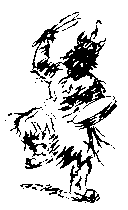|
The Form and Function of the Three Souls |
|||||||
|
All humans and animals possess more than one soul; in fact, multiple souls are required in order to keep a physical body alive. Throughout Siberia and Mongolia it is believed that all humans possess at least three souls; some groups, such as the Samoyed, believe there are more, four in women and five in men. These extra souls, however, are not permanent like the core three souls that all Siberian groups agree upon, and the extra one or two souls gradually dissipate after the death of the physical body. Animals also possess souls that return again and again to their habitat and must therefore not be offended. Human beings possess three souls (for simplicity, I give only the Mongolian names): |
|||||||
|
The three souls reside in the spherical field of energy that envelops the physical body. This sphere has an upright axis within it, pierced by seven holes that correspond to the seven chakras. The suld soul resides at the crown of the head, where there is a direct connection to Father Heaven through the small tenger that is also located there. The other two souls oscillate back and forth through the holes of the body axis in a sine-wave pattern. |
|||||||
|
The ami soul is the soul that enlivens the body. Sometimes it is called the breath soul because it is related to the ability to breathe, amisgal. Breathing is evidence that the ami is within the body; however, at times it will exit the body, resulting in illness. It returns after death to the World Tree, where it roosts in the tree’s branches between heaven and earth in the form of a bird. Ami souls tend to reincarnate among their relatives and are the carriers of ancestral, or so-called genetic, memory. They are under the care of the womb goddess, Umai, who lives beside the World Tree. She dispatches them on spirit horses, omisi murin, to enter the body at the time of birth. While the ami may be temporarily displaced during illness, the ami does not leave permanently until after death. Twins share one ami, which is the reason why there is often a psychic connection between them, especially identical twins. Foxes and wolves are especially sensitive to the presence of stray souls, and when they bark, it is said to be a sign that they have sighted a wandering ami soul. |
|||||||
|
|
||||||
|
|
||||||
 |
||||||